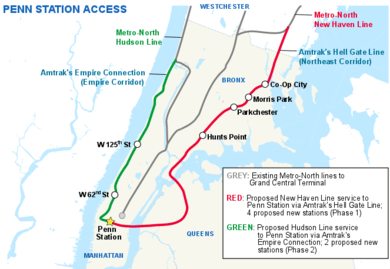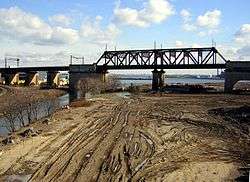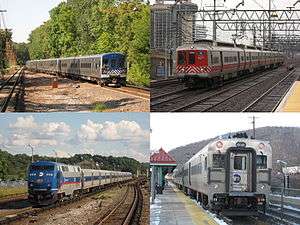Penn Station Access
Penn Station Access is a public works project planned by the Metropolitan Transportation Authority in New York City. The goal of the project is to allow Metro-North Railroad commuter trains to access Penn Station on Manhattan's West Side, using existing trackage that is owned by Amtrak. Metro North trains currently terminate exclusively at Grand Central on Manhattan's East Side.

The project would complement the ongoing East Side Access project, and would commence in two separate phases. The first phase, which is in the planning stage, would add four new stations along the Hell Gate Line (part of the Northeast Corridor) in the Bronx and route some New Haven Line trains to Penn Station. The second phase, which is unfunded, would add two more stations along the Empire Connection/West Side Line on Manhattan's West Side; this would be served by the Hudson Line. An agreement for the first phase was reached in early 2019, and New Haven Line trains are tentatively expected to run into Penn Station in 2024 after East Side Access opens.
Background
While not proposed officially, in June 1973, two Congressmen and the Mayor of Yonkers proposed having trains run from Stamford in Connecticut to Penn Station, making stops at Pelham Manor, Co-op City, and Parkchester/Van Nest. They proposed that the line be operated by the MTA pending completion of the Second Avenue Subway, which was under construction at the time and slated to be completed in 1980. Sixty percent of Co-op City residents that responded to a survey said that they would have used the proposed rail service.[1]
The Penn Station Access project was initiated on September 2, 1999 when the Federal Transit Administration (FTA), in conjunction with Metro-North Railroad, issued a Notice of Intent (NOI) to prepare a Major Investment Study/Environmental Impact Statement (EIS). The EIS was intended to consider possible additions to Metro-North using existing rail lines, with the intention of providing flexibility and increased regional access.[2] Rail alternatives originally considered included Hudson and New Haven service, via the Empire Connection and Hell Gate Line, respectively, and a Harlem Line option via wyes at Mott Haven and Spuyten Duyvil.[3]:A-3[4]

In November 2000, the Final Scoping Document for Penn Station Access was completed, showing 18 alternatives, including a no-build option, a Transportation Systems Management option, various commuter rail options, and alternatives using other modes. Various alternatives considered various ways to run service to Penn Station from the New Haven Line, the Hudson Line, and the Harlem Line, either during all times, or only operating during off-peak hours and weekends. Existing Metro-North riders would have the choice of arriving at either Penn Station or Grand Central on the New Haven Line and the Hudson Line.[5] Service from the New Haven Line would diverge at New Rochelle, using Amtrak's Hell Gate Line to access Penn Station, while service from the Hudson Line would split off at Spuyten Duyvil station via Amtrak's Empire Connection. The alternatives via the Harlem Line would have required the construction of wye tracks. One option would have branched off of the Harlem Line at Mott Haven, using a wye track to go north via the Hudson Line. Using a newly-constructed wye track at Spuyten Duyvil, service would turn south via the Empire Connection before reaching Penn Station. Another option considered would have constructed a wye track at Woodlawn, allowing Harlem trains to go east and head down the Hell Gate Line to Penn Station. The final option would have required the reconstruction of the Port Morris Branch and the Hell Gate Line. An additional option would have extended service from Grand Central to Penn Station through the construction of a new tunnel.[6]:14–16[7]
In September 2002, a second screening took place narrowing five alternatives to four, and narrowing 20 potential station locations in the Bronx, Queens and Manhattan to five locations. The remaining alternatives considered would have used either the Hudson or New Haven Lines. The Harlem Line options were removed from consideration. The five remaining stations under consideration were at West 125th Street and West 59th Street under the Hudson alternative, and at Co-Op City, Parkchester and Hunts Point under the New Haven alternative.[8] The preferred alternatives would have used three miles of trackage, and would have involved the construction of six new Metro-North stations in the Bronx and Manhattan, allowing riders in these areas to easily access Penn Station, Westchester, Dutchess, and Putnam counties upstate as well as Fairfield and New Haven counties in Connecticut.[9][10] Existing Metro-North riders would have the choice of arriving at either Penn Station or Grand Central on the New Haven Line and the Hudson Line.[5]
Afterwards, in coordination with the current rail operators at Penn Station (Amtrak, LIRR, and New Jersey Transit) it was determined that there were several operational limitations with the Hudson Line service alternative, mainly because the Empire Line's connection into Penn Station consists of only one track. The connection only leads to tracks 1-8 at Penn, which are used primarily by NJ Transit, with some usage by Amtrak. Since the implementation of Penn Station Access via the Hudson Line would have required substantial service reductions to those Penn Station tracks by NJ Transit and Amtrak or a new connection between the Empire Line and the LIRR tracks at Penn, progress did not continue on this alternative. Even though the Hell Gate Line alternative was chosen, this alternative is still being considered by Metro-North as capacity improvements at Penn Stations are underway, such as the Gateway tunnels.[11] Penn Station Access would also provide system resiliency to protect service in the event of natural or other disasters.[12]
By 2011, Metro-North had initiated a federal environmental study for Penn Station Access, to be completed by 2013. The cost of the project was estimated at $350 million with the state of Connecticut funding $100 million and the state of New York funding the remaining $250 million.[13][14]
Phase One
_(37771815974).jpg)
The first piece of Penn Station Access would route some New Haven Line trains down Amtrak's Northeast Corridor to Penn Station. The New Haven Line to Grand Central splits off from the Northeast Corridor near New Rochelle. The Northeast Corridor (also known here as the Hell Gate Line) continues south crossing the Pelham Bay Bridge into the Bronx, the Hell Gate Bridge into Queens, and entering Manhattan through the East River Tunnels also used by the Long Island Rail Road. This phase includes the construction of four new Metro-North stations in the Bronx to be served by the New Haven Line, located in Co-op City, Morris Park, Parkchester/Van Nest, and Hunts Point.[10] The stations would provide fast, direct rides to West Midtown and facilitate reverse-commuting trips to Westchester County and Connecticut.[12] The new stations would provide transit access to the transit-deficient East Bronx.[15]
Previously, a station was also considered to be built in Astoria; however, analysis showed that there wouldn’t be enough riders to justify the high cost of constructing a station.[16][17] The construction of a station was projected to cost over $20 million, and the station would only be able to be 4-car lengths long. The station would only have a projected annual ridership of 310,367.[17] Since 2014, local residents have pushed to have a Metro-North station built in Queens, either between 41st and 44th Streets in Astoria, or at Northern Boulevard and Broadway in Woodside.[18][19][20]
On January 8, 2014, New York Governor Andrew Cuomo voiced support for the project in his 2014 State of the State address.[12] With his support for the project, $695 million was budgeted for the project in the MTA's 2015–2019 Capital Program.[21] In order to accommodate more trains, power and signal systems, and yards at Penn Station and New Rochelle[22] will be upgraded and three railroad bridges will be rehabilitated or replaced.[15] In addition, a third track will be installed between the Parkchester/Van Nest station and north of the Co-Op City station, and additional switches will be added. Metro-North service to Penn Station will begin after the completion of the East Side Access project, which will divert some Long island Rail Road trains to Grand Central, therefore opening up slots at Penn Station for Metro-North service.[21] During peak hours there will be between six and ten trains to Penn Station. There will be four trains per hour to Connecticut in the reverse peak direction, and there will be two trains per hour to and from Penn Station during off-peak and weekends.[23]
The project would add redundancy to the regional transportation network in case of service interruption. Regional connectivity will be increased with accessible transfers to Amtrak, the Long Island Rail Road and New Jersey Transit at Penn Station. Through-running between the New Haven Line and New Jersey Transit would be possible, linking business centers in Connecticut and New Jersey while providing access to Newark Liberty Airport.[23] The draft Environmental Assessment was to be made available for public review in late 2018.[11]
At the MTA's Metro-North Railroad Committee meeting on January 22, 2019, it was announced that Amtrak and the MTA had reached an agreement regarding track usage rights, and $35 million was approved for initial engineering design work.[24] In addition, HNTB New York Engineering and Architecture received a $35 million contract to consult on the planning of the four new stations.[25][26][27] In exchange for being allowed to use the Hell Gate Line and build the four stations, the MTA agreed to replace the Pelham Bay Bridge across the Hutchinson River, as well as pay access fees for using the Hell Gate Bridge. Amtrak and the MTA also agreed to conduct a joint study on the feasibility of extending Amtrak service to Long Island via the tracks used by the LIRR.[28][29] As part of the project, three track interlockings would be built, one existing interlocking would be rehabilitated, and the line would be widened from three to four tracks between the Hell Gate and Pelham Bay Bridges.[30]:50 Design for the project began in February 2019, and construction is expected to begin in late 2020, with an expected opening by 2023.[30]:53 By February 2020, the MTA had identified three firms that were qualified to bid on the design–build contracts for Penn Station Access. At that point, the project's opening date was announced as 2024.[31][32]
Existing service
New Haven Line service to Penn Station already existed in a very limited fashion, the Train to the Game, which ran between New Haven and New Jersey Transit's Secaucus Junction. Connecting service to Meadowlands station brought riders to Sunday 1 PM NFL games played by the New York Jets and New York Giants. This special service, operated using New Jersey Transit's equipment, stopped at Penn Station, but that was only a secondary benefit of the operation.[33]
Phase Two

The second part of the project would bring Hudson Line trains into Penn Station using Amtrak's Empire Connection, which runs on Manhattan's West Side via the West Side Line. The Empire Connection branches off from the Hudson Line near Spuyten Duyvil station, just north of the eponymous bridge across Spuyten Duyvil Creek, and is currently used by Amtrak's Empire Corridor trains traveling from Upstate New York, Canada, and other destinations. The majority of the Empire Connection is not electrified, so the M3 and M7 electric railcars in use on the Hudson Line would be unable to travel to Penn Station unless the line is electrified. The former NYC lines, including the Hudson Line, use under-running third rail. Tracks in Penn Station and on the LIRR use over-running third rail. Any Metro-North cars travelling from the Hudson Line to Penn Station would have to be specially equipped to operate with both current collection systems. This phase includes a proposal for two new Metro-North stations to be served by the Hudson Line. Both stations would be located in Manhattan along the Empire Connection: one at West 125th Street in Manhattanville and the other near 62nd Street on the Upper West Side.[34]
Possible Harlem Line service
It has been proposed to have Harlem Line access to Penn Station as well by reactivating the abandoned Port Morris Branch in the South Bronx. The reactivated railroad branch would connect the Harlem Line to the Hell Gate Line.[20] However, these plans have been complicated due to the private ownership of the land next to the right-of-way,[35] as well as a new housing development directly on the right-of-way at 156th Street.[36]
References
- Hudson, Edward (June 9, 1973). "A NEW RAIL LINK SOUGHT FOR BRONX". The New York Times. ISSN 0362-4331. Retrieved December 25, 2016 – via New York Times Archive.
- "Penn Station Access Study". web.mta.info. Metropolitan Transportation Authority. Retrieved September 26, 2017.
- "FINAL SCOPING DOCUMENT Major Investment Study/ Draft Environmental Impact Statement for Penn Station Access" (PDF). mta.info. Metropolitan Transportation Authority. November 2000. Retrieved September 27, 2017.
- "Penn Station Access Study". Mta.info. Retrieved April 23, 2015.
- Stephen Jacob Smith. "West Side vs. East Side (Access): Upper West Side May Get Metro-North Stop". Observer.com. Retrieved April 23, 2015.
- "FINAL SCOPING DOCUMENT Major Investment Study/ Draft Environmental Impact Statement for Penn Station Access" (PDF). mta.info. Metropolitan Transportation Authority. November 2000. Retrieved September 27, 2017.
- "Metro-North PENN STATION ACCESS MIS/DEIS Comparative Screening Results Report (September 2002)" (PDF). mta.info. Parsons Brinckerhoff Quade & Douglas, Inc. September 2002. Retrieved February 17, 2016.
- "Penn Station Access Study". web.mta.info. Metropolitan Transportation Authority. Retrieved September 26, 2017.
- "Penn Station Access Study". Mta.info. Retrieved April 23, 2015.
- "Final Scoping Document : Major Investment Study / Draft Environmental Impact Statement for Penn Station Access" (PDF). Web.mta.info. Retrieved April 23, 2015.
- "Penn Station Access Background". web.mta.info. Metropolitan Transportation Authority. July 2018. Retrieved July 4, 2018.
- "Metro-North Penn Station Access" (PDF). mta.info. Metropolitan Transportation Authority. Retrieved February 17, 2016.
- Rocchio, Patrick (November 10, 2011). "MTA may build four new Metro-North stations". Bronx Times Reporter. p. 1. Retrieved November 20, 2011.
- Beekman, Daniel (December 28, 2011). "New passenger rail service for the East Bronx gaining steam with the MTA bigwigs and boro leaders all aboard". New York Daily News. p. 29. Retrieved December 29, 2011.
- "MTACC Quarterly Progress Report to CPOC Penn Station Access Project Overview December 12, 2016" (PDF). mta.info. Metropolitan Transportation Authority. December 12, 2016. Retrieved January 27, 2017.
- "Petition for Metro-North station in Queens". NY Daily News. Retrieved February 17, 2016.
- "Metro-North PENN STATION ACCESS MIS/DEIS Comparative Screening Results Report (September 2002)" (PDF). mta.info. Parsons Brinckerhoff Quade & Douglas, Inc. September 2002. Retrieved February 17, 2016.
- "Locals Pushing for Metro-North Stations in Queens". DNAinfo New York. Archived from the original on March 6, 2016. Retrieved February 17, 2016.
- "Petition for Metro-North station in Queens". NY Daily News. Retrieved February 17, 2016.
- "Metro-North PENN STATION ACCESS MIS/DEIS Final Scoping Document" (PDF). mta.info. Parsons Brinckerhoff Quade & Douglas, Inc. Edwards and Kelcey, Inc. Retrieved February 17, 2016.
- "MTA 2015-2019 Capital Program, pages 152 and 225" (PDF). Retrieved January 11, 2016.
- "PSA: Shops & Yards". mta.info. Metropolitan Transportation Authority. Retrieved February 1, 2017.
- "Connecticut Presentation (2013)" (PDF). mta.info. Metropolitan Transportation Authority. March 2013. Retrieved January 27, 2017.
- "MTA | news | Project to Build Bronx Metro-North Stations Advances". www.mta.info. Retrieved January 22, 2019.
- "Metro-North riders will finally get Penn Station access". am New York. January 22, 2019. Retrieved January 23, 2019.
- Spivack, Caroline (January 22, 2019). "MTA to build new Metro-North stations linking Bronx to Penn Station". Curbed NY. Retrieved January 23, 2019.
- "Metro-North Railroad Committee Meeting" (PDF). Metropolitan Transportation Authority. January 2019. p. 79. Archived from the original (PDF) on January 21, 2019. Retrieved January 18, 2019.
- "Amtrak, Metro-North Reach Deal on Bronx Expansion Plans - New York Public Radio, Podcasts, Live Streaming Radio, News". WNYC. January 22, 2019. Retrieved January 23, 2019.
- "Penn Station Access Project gets green light, will open West Side to Westchester commuters for first time". The Journal News. January 22, 2019. Retrieved January 23, 2019.
- "Capital Program Oversight Committee Meeting" (PDF). Metropolitan Transportation Authority. April 2019. Retrieved January 18, 2019.
- "MTA selects qualified bidders for Penn Station access project. For Railroad Career Professionals". Progressive Railroading. Retrieved February 12, 2020.
- "MTA identifies firms qualified to bid to design and build Metro-North Penn Station Access Project". Mass Transit. February 12, 2020. Retrieved February 12, 2020.
- "MNR Schedules". Retrieved December 10, 2018.
- "Penn Station Access Proposed "Build" Alternative" (PDF). mta.info. Metropolitan Transportation Authority. Retrieved February 17, 2016.
- "Archived copy" (PDF). Archived from the original (PDF) on March 4, 2016. Retrieved November 5, 2015.CS1 maint: archived copy as title (link)
- Anuta, Joe (November 2, 2015). "Green space or mass transit? A forgotten South Bronx rail line is suddenly the center of attention". Crain's New York Business. Retrieved November 4, 2015.
